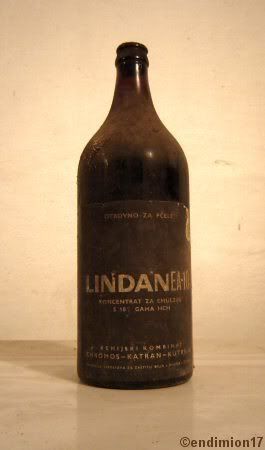
Endimion17 - 23-9-2012 at 13:52
I've got this vintage bottle of Lindane I found in the depths of my basement couple of years ago. It's a thick walled, corked bottle. I decided to
leave it alone as it's a piece of history, and it looks kind of creepy. It might be from the 60's, but I'm not sure.
Currently, this is the highest resolution photo I can provide.

It says "poisonous to bees" at the top, LINDAN EA-10, concentrated solution for emulsion, 5-10% gama HCH, at least I think so. The second number might
be 18%, but let's say it's 10.
The bottom of the label is the company info.
Now I'm thinking about actually doing something about it, but it's not easy to find properties of such compounds, let alone pesticide mixtures.
As I never actually opened the bottle (I feared the cork might break into pieces), I don't know the smell of the liquid inside.
I don't have the bottle here with me, but I remember the liquid was quite dark. Or maybe the glass was.
inchem.org provides this data:
melting point (°C) = 112.8
density (20°C) (g/ml) = 1.85
vapour pressure (mmHg) (20°C) = 3.26 x 10-5
relative molecular mass = 290.85
n-octanol/water partition coefficient (log Pow) = 3.2-3.7
solubility in water (mg/litre) (20°C) = 10 (slightly soluble)
solubility in:
- ethanol - 6.7%
- mineral oils - slightly
- acetone, aromatic, and chlorinated solvents - soluble
What do you know about commercial Lindane? What's the most common solvent that I can expect inside?
Judging on the solvent, what's your opinion on extracting HCH out?
If it's a concentrated solution, and its use is to make an emulsion (obviously in water, as it was to be sprayed around), and it didn't evaporate
through a cork all these decades, what could the solvent be?
Something tells me it could be a heavy chlorinated solvent.
The bottle was in almost pitch dark conditions since it was bought, but nevertheless, I don't know if something happened to the compounds inside.
Lindane is very stable, but judging on the solvent and traces of oxygen, a number of reactions could've taken place.
So... knock yourself out. 
p.s.: at least the bugs never laid a hand on the cork. 
[Edited on 24-9-2012 by Endimion17]
benzylchloride1 - 23-9-2012 at 22:02
I would put the solution in a large flask and distill the solvent off through a good column, and then recrystallize the lindane from ethanol as a
first suggestion.
Dr.Bob - 24-9-2012 at 07:44
I don't know if it distills easily at STP. It will extract easily into chlorinated solvents as it is highly chlorinated itself. it is more toxic
to people than some other older pesticides, like DTT, so use some caution.
If you find any chlordane, keep it, it is still great for termite prevention, and has a useful life of about 40-50 years when absorbed on clay based
soils. I'm still kicking myself for not getting some a freind had years ago before some one got rid of it.
Endimion17 - 24-9-2012 at 08:37
Yeah, that was my initial concern, that I couldn't really use distillation to remove the solvent. The liquid seemed to be quite heavy, kind of
sloshing inside like diesel fuel.
It has to be something that doesn't evaporate easily.
I guess I'll have to remove the stuck cork somehow (it's barely sticking out), and pour the liquid out. I wonder how it looks like.
Thanks for the concern, I'm aware of the danger and won't do anything before some analysis is done on tiny batches, like boiling point, etc.



